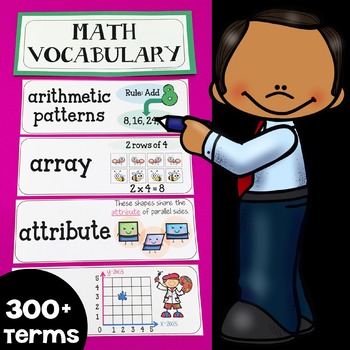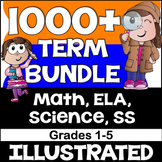Math Vocabulary Cards Word Wall for 3rd, 4th & 5th Grades {Focus Wall}
- Zip
What educators are saying
Also included in
- This is a bundle of ALL of our vocabulary resources at a huge discount price. Please see the individual preview files for each resource. This product is sold AS IS meaning it is NOT EDITABLE. Due to licensing restrictions on the clip art and fonts used within the file, we are not allowed to offerPrice $25.00Original Price $45.94Save $20.94
- Since I can't offer you a classroom break, at least you get a break in the price for these 125+ resources to keep your class busy all year long. Once purchased, just download the resource you need and you're set to go. Come back to your purchases at any time to download what you need at that time.Price $125.00Original Price $358.78Save $233.78
- This resource includes our CCSS I Can Statement Posters and our NGSS Science I Can Statement Posters for Grades K-5. It also includes our general vocabulary resources for ELA, Math, Science, and Social Studies. The vocabulary was custom created by us and does not align specifically to any standardPrice $61.88Original Price $111.88Save $50.00
Description
This math word wall cards resource is intended to be used with students in Grades 3-5. This math word wall resource includes 303 vocabulary words, phrases, and concepts. This math word wall resource goes far beyond the words frequently used in the Common Core Standards and includes tons of important vocabulary words that students NEED TO KNOW in order to be successful.
BUY NOW, PRINT LATER, USE FOREVER!
Important Notes
This resource includes some vocabulary also covered in our Math Word Wall Cards for Grades K-2. We feel that these terms are important for students of multiple grade levels and therefore have been included in this product as well. When applicable, the visual example for the vocabulary word has been made more difficult to cater to the higher grade levels. If you've previously purchased our primary math word wall vocabulary cards, please review the list of words in the preview file carefully prior to purchasing. Also, this resource includes the same words and examples as our Interactive Math Notebook Resource. However, this resource has been reformatted to make both the vocabulary word and the illustrated example larger and there is no formal definition included. The cards are intended to be used to build beautiful and large math word walls in your classroom.
Other Math Word Wall Resources
Supplemental Common Core Standards Resources
Common Core Standards "I Can Statements" - Math & ELA Bundle (1st Grade)
Common Core Standards "I Can Statements" - Math & ELA Bundle (2nd Grade)
Common Core Standards "I Can Statements" - Math & ELA Bundle (3rd Grade)
Common Core Standards "I Can Statements" - Math & ELA Bundle (4th Grade)
Common Core Standards "I Can Statements" - Math & ELA Bundle (5th Grade)
Common Core Standards "I Can Statements" - Math & ELA Bundle (6th Grade)
This product is sold AS IS meaning it is NOT EDITABLE. Due to licensing restrictions on the clip art and fonts used within the file, we are not allowed to offer this as an editable document.
This math word wall vocabulary resource makes for quick and easy setup of a math vocabulary bulletin board display, a math focus wall, or simply a math vocabulary reference for your students.








